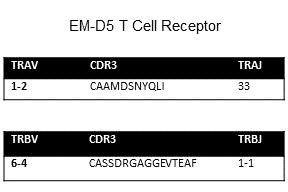Immorta-MAIT T cell clone EM-D5 cell line
Invented at Oregon Health & Science University
- Datasheet
- References (3)
- Inventor Info
Info
| Catalogue Number | 159689 |
| Host | Human |
| Disease Keywords | Mycobacterium tuberculosis |
| Model | Immortalised Line |
| Relevance | Mucosal-associated invarient T (MAIT) cells are innate-like T cells (a subset of T cells) that are found in blood, liver, lungs, and mucosa and are known to play a role in defense against bacterial and viral infections. MAITs have also been shown to potentially play a role in autoimmune diseases such as multiple sclerosis, rheumatiod arthritis, and systemic lupis erythematosus. |
| Production Details | Generated by single cell isolation of MR1/5-OP-RU tetramer+ cells from a human thymus. Single cells were rapidly expanded into a T cell clone using antibody to CD3 (clone OKT3) and IL-2. |
| Conditional | No |
| Research Area | Immunology, Bacteriology |
| Growth/Phenotype Keywords | TRAV1-2 is expressed uniformly (determined by flow cytometry staining). This clone expresses CD4, CD8, CD161, and CD27 and can be classified as a double-positive thymocyte. This T cell clone binds the MR1/5-OP-RU tetramer but not MR1/6FP tetramer (negative control). Clone is MR1-restricted in its production of IFN-gamma by ELISPOT test, determined by its response to M. smegmatis-infected A549 cell line but not a M. smegmatis-infected MR1-\- A549 cell line. |
| Recommended Growing Conditions |
Can be use with conventional T cell expansion methods and proliferates under simple culture methods. Cell line can be maintained for at least 3 months. Cultures can be established by centrifugation with subsequent resuspension at 1 x 10^5 viable cells/mL in complete RPMI-1640 medium (10% heat-inavtivated FBS). Optional recombinant IL-2 at 1ng/mL. T-25 flask is recommended for culturing. Recommended concentration to maintain cultures between 1x10^5 and 1x10^6 viable cells/mL. Fresh medium recommended weekly, based on density and growth rate. |
References: 3 entries
Laugel et al. 2016. J Immunol. 197(3):971-82. PMID: 27307560.
Corbett et al. 2014. Nature. 509(7500):361-5. PMID: 24695216.
Gold et al. 2010. PLoS Biol. 8(6):e1000407. PMID: 20613858.
Add a reference
References: 3 entries
Laugel et al. 2016. J Immunol. 197(3):971-82. PMID: 27307560.
Corbett et al. 2014. Nature. 509(7500):361-5. PMID: 24695216.
Gold et al. 2010. PLoS Biol. 8(6):e1000407. PMID: 20613858.
Add a reference





